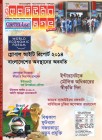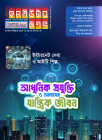হোম >
লেখক পরিচিতি
লেখকের নাম:
মো: জাবেদ মোর্শেদ চৌধুরী
মোট লেখা:২৫
লেখা সম্পর্কিত
পাবলিশ:
২০১৪ - জুন
তথ্যসূত্র:
কমপিউটার জগৎ
লেখার ধরণ:
আইসিটি
তথ্যসূত্র:
ইংরেজি সেকশন
ভাষা:
ইংরেজি
স্বত্ত্ব:
কমপিউটার জগৎ
ICT for Disaster Risk Management in Bangladesh
Natural disaster prone Bangladesh is one of the most vulnerable countries in the world to cyclone, draught, tsunami, landslide, earthquake, arsenic contamination, salinity intrusion, erosion and of course floods. According to UN studies, the country is the most risky of being affected by tropical cyclones and sixth in the global vulnerability ranking caused by flooding. A study by the intergovernmental panel on climate change (IPCC) shows that by 2050, one in every seven persons (approximate population now is 158,570,535) in Bangladesh will be displaced by climate change. 32 per cent of total Bangladesh can be considered as coastal regions and nearly 39 percentage (and with a population growth of 1.3 per cent, by 2020, it will be 44 per cent) of the total population lives in such places.
Role of ICT in Disaster Risk Management
Information and Communication Technologies (ICTs) have a critical role to play in combating climate change through the reduction of global green house gas (GHG) emissions. The increased use of ICTs contributes to global warming — millions of television sets and computers are never fully turned off at night in homes and offices. But ICTs can also be a key part of the solution, because of the role they play in monitoring, mitigating and adapting to climate change.
The ICT sector itself (in this definition, telecommunications, computing and the internet, but excluding broadcasting) contributes around 2 to 2.5 percent of GHG, at just under one Gigatonne of CO2 equivalent. The main constituent (40 percent) of this is the energy requirements of personal computers and data monitors, with data centres contributing a further 23 percent. Fixed and mobile telecommunications contribute an estimated 24 percent of the total.
International Telecommunications Union (ITU) working in this area focuses on the use of ICTs (including weather satellites, radio and telecommunication technologies) in weather forecasting, climate monitoring and predicting, detecting and mitigating the effects of natural disasters.
Another important way in which ICTs can respond to climate change is in the area of disaster prevention and relief. In Bangladesh we can promote the use of telecommunications/ICT for disaster prevention and disaster relief. In many cases when disaster strikes, the ‘wired’ telecommunication infrastructure is significantly or completely destroyed and only radio communication services can be used for disaster relief operations — especially radio amateurs and satellite systems. We had tremendous experiences during Cyclone Sidr (November 15, 2007) that Radio and Cell phone were engaged in direct missions to help affected people.
We can work in this field with standardization of call priority in emergency situations, for example Recommendation E.106 on the International Emergency Preference System for disaster relief. ITU-T has also assigned a special E.164 country code (888) to the United Nations Office for the Coordination of Humanitarian Affairs (OCHA) for the purpose of facilitating the provision of an international system of naming and addressing terminals involved in disaster relief activities.
Online data base system can be one of the solutions in distributing relief among the victims. Significantly, it will boost monitoring the distribution process by the elected people’s representatives and consequently, misuse of funds and relief goods will be checked.
Digital mapping is a must for a modern country. In a country that possesses up-to-date mapping of a region, a rescue worker would be able to locate a victim by simply using a palmtop and a mobile phone. Digital mapping is extremely useful in finding victims in a zone where an accident occurs. Whenever a mishap takes place, rescuers can identify the place of occurrence by clicking on a handheld device. Digital mapping is a useful tool in the search for scattered people after a disaster like cyclone, hurricane and flood.
Remote sensing has taken a new turn with the installation of satellite equipment, which allows observation from a distant location and produces images to analyse what is going on exactly. Images are taken from the surface of the Earth and the photos are projected on computer monitors for zoom in.
Still we are far off from the latest remote sensing facilities. The space equipment of the remote sensing organisation, Bangladesh Space Research and Remote Sensing Organisation (SPARRSO), is not enough. It is associated with some satellite establishments of other countries and images from those satellites help them to carry out remote sensing operation.
A country, whether rich or not, needs donation and help from all over the world during a natural calamity. Other governments and international organisations can send donations to the victims, but general people normally face a hassle in donating money from other parts of the world; there is even a limitation in some particular countries about sending money instantly and directly. Bangladesh Bank has opened the gateway for online payment which will facilitate collecting donations and sending money to a victim directly.
Adaptation
It is a high time to create enabling conditions in Bangladesh for promoting adaptation to climate change and climate variability in national policies and plans and also to create awareness of the phenomenon at the local community level with special focus on the residents of the north, south and eastern areas.
The impact of global warming on the world’s climate will continue, even if the level of GHG emissions is stabilized. Further, the impact is likely to be highly uneven. With low-lying coastal areas (such as small islands states, the Bangladesh delta and the Netherland) at risk because of rising sea levels and food insecurity, health hazards, growing number of environmental refugees, and increased pressure on sources of fresh water and vulnerable ecosystems, adaptation to climate change is a key necessity for us and the global community at large.
Conclusion
The government alone cannot address the response measures to adaptation of ICTs for mitigation of climate change impact in Bangladesh. The civil societies, NGOs, local communities will have to be sensitized and prepared to work with the government agencies. Public awareness, education and training will be most critical tool to involve all sections of the public in the process.
Funding can be realized for capacity building and other measures, which will help implement parts of the national development plan. It will require the human resources development in ICT sector. The Ministry of Science and Technology can take the lead
Role of ICT in Disaster Risk Management
Information and Communication Technologies (ICTs) have a critical role to play in combating climate change through the reduction of global green house gas (GHG) emissions. The increased use of ICTs contributes to global warming — millions of television sets and computers are never fully turned off at night in homes and offices. But ICTs can also be a key part of the solution, because of the role they play in monitoring, mitigating and adapting to climate change.
The ICT sector itself (in this definition, telecommunications, computing and the internet, but excluding broadcasting) contributes around 2 to 2.5 percent of GHG, at just under one Gigatonne of CO2 equivalent. The main constituent (40 percent) of this is the energy requirements of personal computers and data monitors, with data centres contributing a further 23 percent. Fixed and mobile telecommunications contribute an estimated 24 percent of the total.
International Telecommunications Union (ITU) working in this area focuses on the use of ICTs (including weather satellites, radio and telecommunication technologies) in weather forecasting, climate monitoring and predicting, detecting and mitigating the effects of natural disasters.
Another important way in which ICTs can respond to climate change is in the area of disaster prevention and relief. In Bangladesh we can promote the use of telecommunications/ICT for disaster prevention and disaster relief. In many cases when disaster strikes, the ‘wired’ telecommunication infrastructure is significantly or completely destroyed and only radio communication services can be used for disaster relief operations — especially radio amateurs and satellite systems. We had tremendous experiences during Cyclone Sidr (November 15, 2007) that Radio and Cell phone were engaged in direct missions to help affected people.
We can work in this field with standardization of call priority in emergency situations, for example Recommendation E.106 on the International Emergency Preference System for disaster relief. ITU-T has also assigned a special E.164 country code (888) to the United Nations Office for the Coordination of Humanitarian Affairs (OCHA) for the purpose of facilitating the provision of an international system of naming and addressing terminals involved in disaster relief activities.
Online data base system can be one of the solutions in distributing relief among the victims. Significantly, it will boost monitoring the distribution process by the elected people’s representatives and consequently, misuse of funds and relief goods will be checked.
Digital mapping is a must for a modern country. In a country that possesses up-to-date mapping of a region, a rescue worker would be able to locate a victim by simply using a palmtop and a mobile phone. Digital mapping is extremely useful in finding victims in a zone where an accident occurs. Whenever a mishap takes place, rescuers can identify the place of occurrence by clicking on a handheld device. Digital mapping is a useful tool in the search for scattered people after a disaster like cyclone, hurricane and flood.
Remote sensing has taken a new turn with the installation of satellite equipment, which allows observation from a distant location and produces images to analyse what is going on exactly. Images are taken from the surface of the Earth and the photos are projected on computer monitors for zoom in.
Still we are far off from the latest remote sensing facilities. The space equipment of the remote sensing organisation, Bangladesh Space Research and Remote Sensing Organisation (SPARRSO), is not enough. It is associated with some satellite establishments of other countries and images from those satellites help them to carry out remote sensing operation.
A country, whether rich or not, needs donation and help from all over the world during a natural calamity. Other governments and international organisations can send donations to the victims, but general people normally face a hassle in donating money from other parts of the world; there is even a limitation in some particular countries about sending money instantly and directly. Bangladesh Bank has opened the gateway for online payment which will facilitate collecting donations and sending money to a victim directly.
Adaptation
It is a high time to create enabling conditions in Bangladesh for promoting adaptation to climate change and climate variability in national policies and plans and also to create awareness of the phenomenon at the local community level with special focus on the residents of the north, south and eastern areas.
The impact of global warming on the world’s climate will continue, even if the level of GHG emissions is stabilized. Further, the impact is likely to be highly uneven. With low-lying coastal areas (such as small islands states, the Bangladesh delta and the Netherland) at risk because of rising sea levels and food insecurity, health hazards, growing number of environmental refugees, and increased pressure on sources of fresh water and vulnerable ecosystems, adaptation to climate change is a key necessity for us and the global community at large.
Conclusion
The government alone cannot address the response measures to adaptation of ICTs for mitigation of climate change impact in Bangladesh. The civil societies, NGOs, local communities will have to be sensitized and prepared to work with the government agencies. Public awareness, education and training will be most critical tool to involve all sections of the public in the process.
Funding can be realized for capacity building and other measures, which will help implement parts of the national development plan. It will require the human resources development in ICT sector. The Ministry of Science and Technology can take the lead
লেখাটি পিডিএফ ফর্মেটে ডাউনলোড করুন
লেখাটির সহায়ক ভিডিও
পাঠকের মন্তব্য
অনুরূপ লেখা



